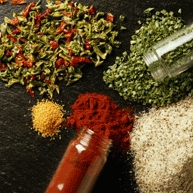Herbs & Spices for Added Taste, Pleasure and Health
 One of the greatest pulls for a chronic dieter when they embrace the concept of starting on the intuitive eating journey is the idea that they can enjoy their food once again. How does this sound to you? Eating what you truly want to eat, and not what you think you should eat.
One of the greatest pulls for a chronic dieter when they embrace the concept of starting on the intuitive eating journey is the idea that they can enjoy their food once again. How does this sound to you? Eating what you truly want to eat, and not what you think you should eat.
Part of regaining the pleasure of eating is to use all your senses during your eating experience. According to the International Food Information Council Foundation 2013 Food and Health Survey, taste continues to be the most important factor driving consumers’ decisions to buy foods and beverages, with 89% of participants rating the impact of taste as high, versus 64% who said “healthfulness.”
Food should taste good! Think about the flavor, texture and temperature of the food when you cook. Do you have something spicy on your plate? Do you have a combination of crunchy and soft foods? What is your preference? How do you flavor your food?
Healthy food doesn’t have to taste bland. There is no need to pour on the salt to flavor your food. I’m sure you know someone, or maybe it’s you, who picks up the salt shaker before even taking the first bite. Experimenting with various herbs and spices is a great way to lower your intake of salt and gain some wonderful health benefits.
The next time you are cooking in the kitchen, try using the following herbs and spices:
- Chili Peppers: The amount of capsaicin found in chili peppers determines the antioxidant power of the pepper (the hotter the pepper, the more capsaicin it contains, the higher the level of antioxidants). Chili peppers add tons of flavors to burgers, stir fries, salsa, soups, stews and egg dishes.
- Cinnamon: This sweet spice has been shown to reduce inflammation, have antioxidant properties and fight bacteria. Adding a teaspoon of cinnamon to oatmeal, Greek yogurt, tea, coffee, or even into pancake or cookie batters will kick the recipe up a notch. For even more flavor, use with nutmeg, cloves and/or all spice.
- Garlic: Garlic is very popular and is used to add flavor to vegetables, pasta dishes, stir fries, tomato sauce, meat and poultry. It has many therapeutic properties and is said to aid in the prevention of heart disease and certain types of cancer.
- Ginger: Ginger can be used fresh, powdered or dried in a variety of dishes. Similar to garlic, ginger is used as a therapeutic agent to treat inflammation, muscle pain, cancer and asthma symptoms. It’s also a popular food used to treat symptoms of the upper respiratory tract and nausea resulting from cancer treatment, stomach upset, and morning sickness. Grate fresh ginger into quick breads and vinaigrettes or chop it up and add it to stir fries and vegetable dishes. Ginger also adds great flavor to cooked carrots.
- Basil: Basil is the major ingredient in pesto sauce and is used in a lot of Italian dishes. This herb adds fresh flavor to sandwiches, salads, burgers, tomato sauce and pasta dishes. It is known for its ability to reduce inflammation and swelling as well has having anti-aging properties and being a rich source of antioxidants. Use it alongside oregano to magnify the flavor of your meal.
- Thyme: This herb tastes great when added to scrambled eggs, salad dressings, chicken salad, soups or even when used as a rub for salmon. Research has shown that thyme can play a role in the treatment of common skin problems, colon and breast cancer, and yeast infections.
Your turn to take action: What herbs and spices do you love to use to flavor your foods?





Leave a Reply
Want to join the discussion?Feel free to contribute!